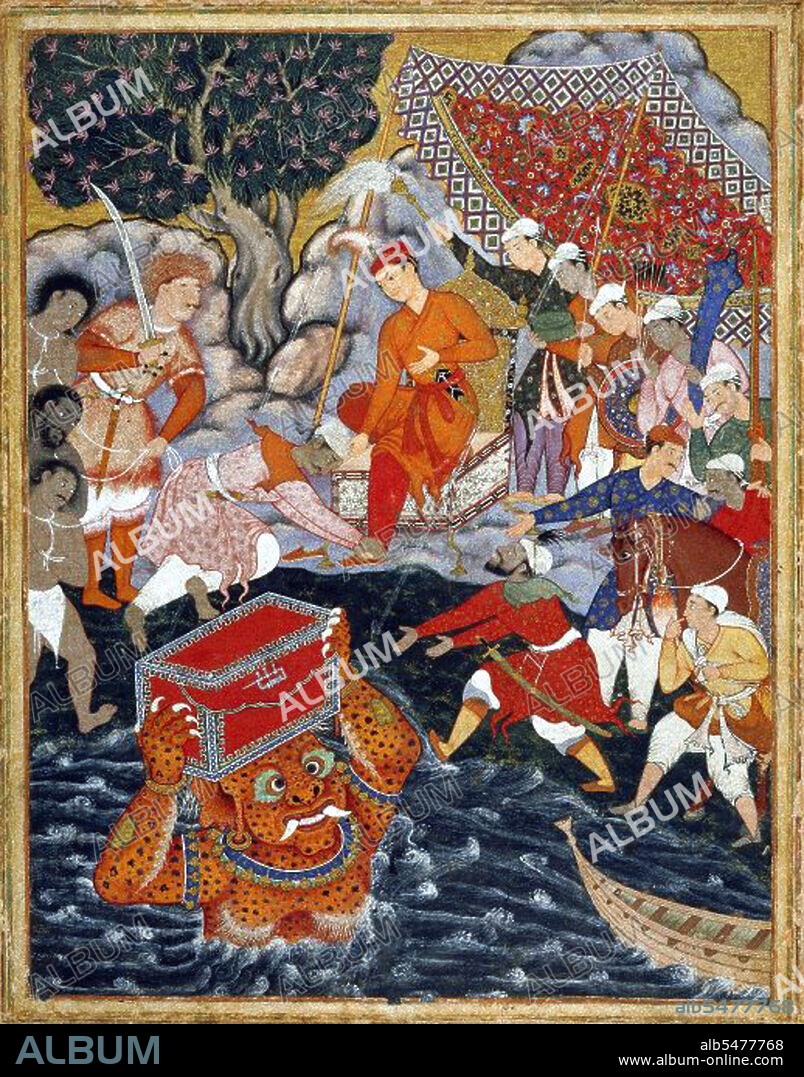alb5477768
India: A scene from the Hamzanama. Div carries a chest of armour through the waters to Hamza, under the supervision of Samad. Mughal painting.

|
Ajouter à une autre Lightbox |
|
Ajouter à une autre Lightbox |



Avez-vous déjà un compte? S'identifier
Vous n'avez pas de compte ? S'inscrire
Acheter cette image.
Sélectionnez l'usage:

Titre:
India: A scene from the Hamzanama. Div carries a chest of armour through the waters to Hamza, under the supervision of Samad. Mughal painting.
Légende:
Traduction automatique: Le Hamzanama ou Dastan-e-Amir Hamza (Aventures d'Amir Hamza) raconte les exploits mythiques d'Amir Hamza, l'oncle du prophète de l'Islam. La majeure partie de l'histoire est extrêmement fantaisiste, décrite de manière mémorable par le premier empereur moghol Babur comme : « un long mensonge tiré par les cheveux, opposé au sens et à la nature ». Pourtant, le Hamzanama s'est avéré durablement populaire auprès du petit-fils de Babur, le troisième empereur moghol Akbar, qui a commandé une magnifique version illustrée de l'épopée vers 1562, dont cette miniature est tirée. Le texte augmentait l'histoire, telle qu'elle est traditionnellement racontée dans les représentations du dastan. Ce roman est né il y a plus de 1 000 ans, probablement en Perse, et s'est ensuite répandu dans tout le monde islamique sous forme orale et écrite. Le Dastan (tradition de conte) sur Amir Hamza persiste jusqu'au Bengale et à l'Arakan (Birmanie) en raison des voyages prétendument répandus de Hamza en Perse, dans l'est de l'Inde, dans l'Himalaya, au Bengale, au Manipur, en Birmanie et peut-être en Malaisie dans sa jeunesse, ou avant d'embrasser l'Islam en 616
The Hamzanama or Dastan-e-Amir Hamza (Adventures of Amir Hamza) narrates the mythical exploits of Amir Hamza, the uncle of the prophet of Islam. Most of the story is extremely fanciful, memorably described by the first Moghul Emperor Babur as: 'one long far-fetched lie, opposed to sense and nature'. Yet the Hamzanama proved enduringly popular with Babur's grandson, the third Mughal Emperor Akbar, who commissioned a magnificent illustrated version of the epic in c.1562, from which this miniature is taken. The text augmented the story, as traditionally told in dastan performances. This romance originated more than 1,000 years ago, probably in Persia, and subsequently spread throughout the Islamic world in oral and written forms. The Dastan (story telling tradition) about Amir Hamza persists far and wide up to Bengal and Arakan (Burma) due to Hamza's supposedly widespread travelling in Persia, eastern India, the Himalayas, Bengal, Manipur, Burma and perhaps Malaysia in his youth, or before he embraced Islam in 616.
Crédit:
Album / Pictures From History/Universal Images Group
Autorisations:
Modèle: Non - Propriété: Non
Questions sur les droits?
Questions sur les droits?
Taille de l'image:
3800 x 4842 px | 52.6 MB
Taille d'impression:
32.2 x 41.0 cm | 12.7 x 16.1 in (300 dpi)
Mots clés:
ANT. OR.: IRAN • ART (CATÉGORIE) • ART • ART, PEINTURE • ASIE • ASIE, CONTINENT • CONTINENT ASIE • HISOIRE • HISTOIRE • INDE • INDES • INDIEN • INDIENNE • INDIENS • IRAN • IRAN, ANT. OR. • ISLAM • ISLAMIQUE • ISLMAM • LITTÉRATEUR • LITTERATURE • MOGHOL • MUSULMAN • MUSULMANE • MUSUSLMAN • PEINTURE • TABLEAU • TABLEAUX
 Pinterest
Pinterest Twitter
Twitter Facebook
Facebook Copier le lien
Copier le lien Email
Email
